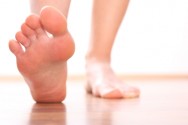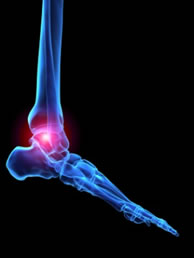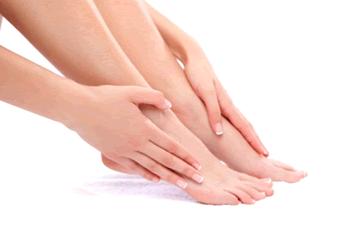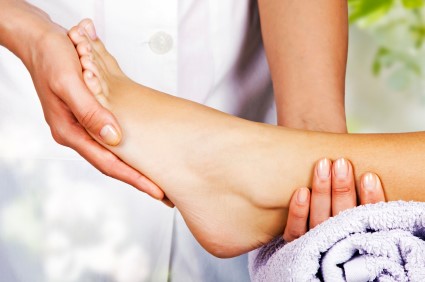Items filtered by date: November 2015
Different Treatments for Heel Pain Prove Effective
 Stiff and persistent heel pain that is not easily supplemented with heel pads or mild painkillers often reveals itself to be plantar fasciitis. Treatment options for plantar fasciitis can involve other anti-inflammatory medications, physical therapy, stretching exercises, night splints, or cortisone injections. While each of these methods are effective, it is important to see a podiatrist or foot specialist who will properly examine the foot and determine the best treatment for each individual.
Stiff and persistent heel pain that is not easily supplemented with heel pads or mild painkillers often reveals itself to be plantar fasciitis. Treatment options for plantar fasciitis can involve other anti-inflammatory medications, physical therapy, stretching exercises, night splints, or cortisone injections. While each of these methods are effective, it is important to see a podiatrist or foot specialist who will properly examine the foot and determine the best treatment for each individual.
Anyone can wind up suffering from heel pain. If your heel is hurting, see one of our podiatrists of The Podiatry Center, P.C. Our podiatristswill treat your heel pain symptoms in addition to other podiatric-related needs.
Causes of Heel Pain
● Heel pain is often associated with plantar fasciitis. The plantar fascia is a band of tissues that extends along the bottom of the foot. A rip or tear in this ligament can cause inflammation of the tissue.
● Achilles tendonitis is another cause of heel pain. Inflammation of the Achilles tendon will cause pain from fractures and muscle tearing. Lack of flexibility is also another symptom.
● Heel spurs are another cause of pain. When the tissues of the plantar fascia undergo a great deal of stress, it can lead to ligament separation from the heel bone, causing heel spurs.
Why Might Heel Pain Occur?
- Wearing ill-fitting shoes
- Wearing non-supportive shoes
- Weight change
- Excessive running
Treatments
Heel pain should be treated as soon as possible for immediate results. Keeping your feet in a stress free environment will help. If you suffer from Achilles tendonitis or plantar fasciitis, applying ice will reduce the swelling. Stretching before an exercise like running will help the muscles. Using all these tips will help make heel pain a thing of the past.
With the advancements in technology and greater knowledge of how muscles and joints work, physical therapists can turn things around dramatically.
If you have any questions about arthritic foot care, please feel free to contact our office located in Millburn, NJ. We offer the newest diagnostic and treatment technologies for all your foot and ankle needs.
Reducing Symptoms Essential to Managing Arthritis
 When it comes to arthritic foot care there is no definitive cure. However, reducing the symptoms and causes of inflammation are key in managing your arthritis. One of the major aspects of this pain management comes in the form of dieting: making sure you get the proper nutrients to help fight inflammation is paramount. Fish, and the omega-3 fatty acids contained in them, have jumped to the top of the list when it comes to combatting inflammation. Researchers have also found that broccoli, which contains sulforaphane, could help prevent or slow the progression of osteoarthritis. Lastly, heart-healthy oils that contain oleocanthal, which have similar properties to non-steroidal, anti-inflammatory drugs, are also highly recommended to those trying to fight the symptoms of arthritis.
When it comes to arthritic foot care there is no definitive cure. However, reducing the symptoms and causes of inflammation are key in managing your arthritis. One of the major aspects of this pain management comes in the form of dieting: making sure you get the proper nutrients to help fight inflammation is paramount. Fish, and the omega-3 fatty acids contained in them, have jumped to the top of the list when it comes to combatting inflammation. Researchers have also found that broccoli, which contains sulforaphane, could help prevent or slow the progression of osteoarthritis. Lastly, heart-healthy oils that contain oleocanthal, which have similar properties to non-steroidal, anti-inflammatory drugs, are also highly recommended to those trying to fight the symptoms of arthritis.
Arthritis can be a difficult condition to live with. If you are suffering from arthritic foot pain, contact one of our podiatrists of The Podiatry Center, P.C. Our podiatrists can treat your foot and ankle needs.
Arthritic Foot Care
Arthritis is a joint disorder that involves inflammation of different joints in your body, such as in your feet. Arthritis is often caused by a degenerative joint disease and causes mild to severe pain in all affected areas. On top of this, swelling and stiffness in the affected joints can also be a common symptom of arthritis.
In many cases, wearing ill-fitting shoes can worsen the effects and pain of arthritis. Wearing shoes that have a lower heel and extra room can help your feet feel more comfortable. In cases of rheumatoid arthritis, the arch in your foot may become problematic. Buying shoes with proper arch support that contour to your feet can help immensely.
Alleviating Arthritic Pain
- Exercises that stretch the foot can prevent further pain and injury and increase mobility
- Most of the pain can be alleviated with anti-inflammatory drugs, heat, and topical medications
- Massages can help to temporarily alleviate pain.
It is best to see your doctor for the treatment that is right for your needs and symptoms. Conditions vary, and a podiatrist can help you determine the right method of care for your feet.
If you have any questions about arthritic foot care, please feel free to contact our office located in Millburn, NJ. We offer the newest diagnostic and treatment technologies for all your foot and ankle needs.
Study Finds Patients in Rural Areas More Susceptible to Diabetic Foot Complications
 According to a study published in PLOS ONE, diabetic patients living in rural areas have a higher chance of a more problematic experience with diabetic foot ulcers. This includes an increase in hospital admittance and risk of major amputation. Research shows that those in rural areas with diabetic foot complications make up 1.9% of 55 million diabetic emergency visits and areas with lower incomes also had a higher risk of amputation.
According to a study published in PLOS ONE, diabetic patients living in rural areas have a higher chance of a more problematic experience with diabetic foot ulcers. This includes an increase in hospital admittance and risk of major amputation. Research shows that those in rural areas with diabetic foot complications make up 1.9% of 55 million diabetic emergency visits and areas with lower incomes also had a higher risk of amputation.
Diabetic foot care is important in preventing foot complications such as ulcers or amputation. If you are suffering from diabetes or have any other concerns about your feet contact one of our podiatrists of The Podiatry Center, P.C. Our doctor will diagnose and treat your foot and ankle needs.
Diabetic Foot Care
Diabetes affects millions of people every year. Diabetes can damage blood vessels in many parts of the body, including the feet. Because of this, taking care of your feet is essential if you have diabetes, and having a podiatrist help monitor your foot health is highly recommended.
The Importance of Caring for Your Feet
- Routinely inspect your feet for bruises or sores.
- Wear socks that fit your feet comfortably.
- Wear comfortable shoes that provide adequate support.
Patients with diabetes should have their doctor monitor their blood levels because blood sugar levels play such a huge role in diabetic care. Monitoring these levels on a regular basis is highly advised.
It is always best to inform your healthcare professional of any concerns you may have regarding your feet, especially for diabetic patients. Early treatment and routine foot examinations are keys to maintaining proper health, especially because severe complications can arise if proper treatment is not applied.
If you have any questions, please feel free to contact our office in Millburn, NJ. We offer the newest diagnostic and treatment technologies for all your foot and ankle needs.
Training Barefoot Strengthens Feet and Body
 Despite the apparent downhill interest in barefoot running, barefoot training in which you exercise and strengthen your feet through a barefoot exercise regimen is a good way to remain flexible and healthy. The other important thing that these barefoot drills do is increase gait pattern which affects the overall biomechanics of walking and running. Since off-kilter feet can lead to injuries in the legs, knees, and back, these barefoot drills have become a great tool to staying healthy and fit.
Despite the apparent downhill interest in barefoot running, barefoot training in which you exercise and strengthen your feet through a barefoot exercise regimen is a good way to remain flexible and healthy. The other important thing that these barefoot drills do is increase gait pattern which affects the overall biomechanics of walking and running. Since off-kilter feet can lead to injuries in the legs, knees, and back, these barefoot drills have become a great tool to staying healthy and fit.
Proper footwear is important for biomechanics, which incorporates the moving parts that manage the movement of your feet. To learn more about biomechanics, see one of our podiatrists from The Podiatry Center, P.C. Our doctors can provide you with the foot and ankle information you seek.
A History of Biomechanics
- Biomechanics dates back to the BC era in Egypt where evidence of professional foot care has been recorded.
- In 1974 biomechanics gained a higher profile from the studies of Merton Root, who claimed that by changing or controlling the forces between the ankle and the foot, corrections or conditions could be implemented to gain strength and coordination to the area.
Modern technology improvements are based on past theories and therapeutic processes providing a better understanding of podiatry concepts for biomechanics. Computers provide accurate determinations about the forces, moments and patterns of the foot and lower legs with the most important information captured.
Advances in materials and more awareness of biomechanics have developed enhanced corrective methods, offering further options for foot-related injuries. Understanding foot biomechanics can help improve and eliminate pain, stopping further stress to the foot.
If you have any questions, please contact our office located in Millburn, NJ. We offer the newest diagnostic and treatment technologies for all your foot care needs.
Increase in Morton’s Neuroma May be Due to High Heels
 Within the past decade, more women have been admitted into the hospital with symptoms leading to Morton’s neuroma. Many scientists believe this spike is due to an increase in high heel usage especially in women ages 40 - 69. In fact, within the past ten years there has been a 115% increase in high heel related Morton’s neuroma treatment; 1,179 admitted women in 2005 and 2,523 admitted women in 2015. Since Morton’s neuroma affects the nerves that run between the toes, high heel shoes over five centimeters can become problematic by pushing the metatarsal bones against the nerves. Many suggest wearing shoes with a wider toe box and a lower heel to avoid this ailment.
Within the past decade, more women have been admitted into the hospital with symptoms leading to Morton’s neuroma. Many scientists believe this spike is due to an increase in high heel usage especially in women ages 40 - 69. In fact, within the past ten years there has been a 115% increase in high heel related Morton’s neuroma treatment; 1,179 admitted women in 2005 and 2,523 admitted women in 2015. Since Morton’s neuroma affects the nerves that run between the toes, high heel shoes over five centimeters can become problematic by pushing the metatarsal bones against the nerves. Many suggest wearing shoes with a wider toe box and a lower heel to avoid this ailment.
Morton’s Neuroma is a very uncomfortable condition to live with. If you think you have Morton’s neuroma contact one of our podiatrists of The Podiatry Center, P.C. Our doctors will treat your foot and ankle needs.
Morton’s Neuroma
Morton's neuroma is a painful foot condition that commonly affects the areas between the second and third or third and fourth toe, although other areas of the foot are also susceptible. Morton’s neuroma is caused by an inflamed nerve in the foot that is being squeezed and aggravated by surrounding bones.
What Increases the Chances of having Morton’s Neuroma?
- -Ill-fitting high heels or shoes that add pressure to the toe or foot
- -Jogging, running or any sport that involves constant impact to the foot
- -Flat feet, bunions, and any other foot deformities
Morton’s neuroma is a very treatable condition. Orthotics and shoe inserts can often be used to alleviate the pain on the forefront of the feet. In more severe cases, corticosteroids can also be prescribed. In order to figure out the best treatment for your neuroma, it’s recommended to seek the care of a podiatrist who can diagnose your condition and provide different treatment options.
If you have any questions please feel free to contact our office located in Millburn, NJ. We offer the newest diagnostic tools and treatments to treat your foot and ankle needs.
